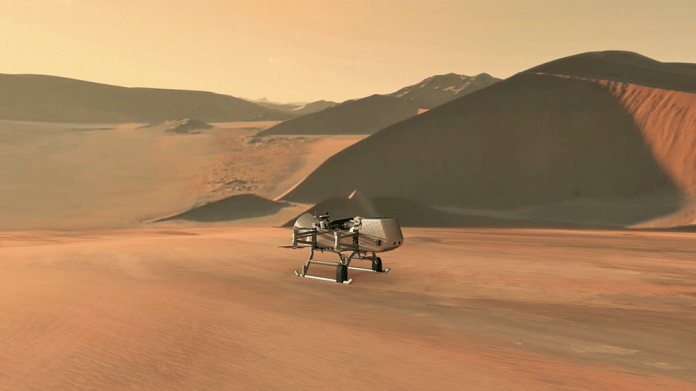New Delhi: NASA has announced its next destination in the solar system — Titan, Saturn’s largest moon, which the US space agency says has shown promising chemical signatures indicating the possibility of life.
Under the mission, named Dragonfly, NASA is set to use a “multi-rotor vehicle” to fly multiple sorties to sample and examine sites around Titan and help advance the understanding of how life evolved. Rotorcraft generally include those aircraft where one or more rotors are required to provide lift throughout the entire flight, such as helicopters.
Dragonfly will launch from Earth in 2026 and is expected to reach Titan in 2034, NASA has announced in a statement.
“The rotorcraft will fly to dozens of promising locations on Titan looking for prebiotic chemical processes common on both Titan and Earth. Dragonfly marks the first time NASA will fly a multi-rotor vehicle for science on another planet; it has eight rotors and flies like a large drone,” the NASA statement said. “It will take advantage of Titan’s dense atmosphere – four times denser than Earth’s – to become the first vehicle ever to fly its entire science payload to new places for repeatable and targeted access to surface materials.”
The moon with a substantial atmosphere
Among the over 150 known moons in the solar system, Titan is the only one with a substantial atmosphere. It is also the only place, besides Earth, known to have liquids in the form of rivers, lakes and seas on its surface.
Unlike the Earth, Titan has clouds and rain of methane.
In its statement, NASA has said data collected over a period of more than 13 years from its Cassini spacecraft helped it choose a calm weather period for Dragonfly to land on Titan, along with a safe initial landing site and scientifically interesting targets.
“Dragonfly will explore diverse environments from organic dunes to the floor of an impact crater where liquid water and complex organic materials key to life once existed together for possibly tens of thousands of years,” the NASA statement said. “Its instruments will study how far prebiotic chemistry may have progressed… Additionally, instruments will search for chemical evidence of past or extant life.”
“Visiting this mysterious ocean world could revolutionize what we know about life in the universe,” the statement quoted NASA Administrator Jim Bridenstine as having said. “This cutting-edge mission would have been unthinkable even just a few years ago, but we’re now ready for Dragonfly’s amazing flight.”
The mission
According to NASA, Dragonfly will first land at the “equatorial Shangri-La dune fields in Titan”, which it says are terrestrially similar to the dunes in Namibia in southern Africa.
The rotorcraft will explore this region in short flights, building up to a series of longer “leapfrog” flights of up to 8 km, stopping along the way to take samples from areas with a diverse geography.
“It will finally reach the Selk impact crater, where there is evidence of past liquid water, organics – the complex molecules that contain carbon, combined with hydrogen, oxygen, and nitrogen – and energy, which together make up the recipe for life,” the NASA statement said. “The lander will eventually fly more than 108 miles (175 km) — nearly double the distance travelled to date by all the Mars rovers combined.”
Also read: NASA opens up the space station to tourists for $50 million a trip



